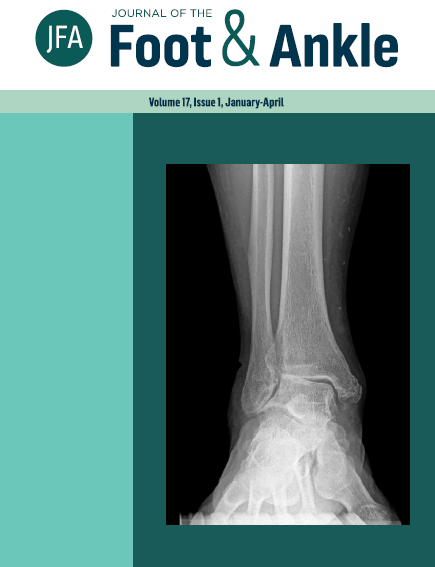The Best of Both Worlds
DOI:
https://doi.org/10.30795/jfootankle.2023.v17.1698Abstract
The minimal invasive surgery in Foot and Ankle is here to stay and its growth and strength is undeniable.
During the 90s in the American continent, forefoot minimal invasive surgery was dominated by North American Podiatrist, during that time the now called “first generation MIS” for Hallux Valgus wasn´t well accepted by orthopedic foot and ankle surgeons.
It was a controversial topic pointed out as a “blind with no fixation technique” that could not be predicted on its outcome. This was supported because of the lack of scientific studies regarding this MIS bunion´s correction and the fact that there were some publications and oral presentations putting it down because of its detrimental outcomes.
In the 2000s and 2010s the orthopedic world started to look more seriously into this ideology and started to do a formal scientific work and resulted in this ultimate generation percutaneous Hallux Valgus correction with hardware fixation backed up with several papers with clinical and radiological outcomes.
Proof of this is the threefold rise in publications on MIS that arouse from 10,127 in med nineties to 30,362 in 2015.
At the same scenario, percutaneous metatarsal osteotomies that were done in despite of Metatarsophalangeal dislocation, found its contraindication on this new paradigm and must be done in an open fashion to reduce it when doing a percutaneous bunion, giving a place to hybrid surgery.
Also Minimal Invasive Queilectomy for Hallux Rigidus yielded more second procedures than open surgery in some publications favoring this latter technique.
Open surgery has been studied for many years reporting good to excellent outcomes in forefoot, midfoot, hindfoot and ankle. Wound Complications and faster recovery time are the main factors that pulled the indications for some open procedures to be done in a minimal invasive fashion like Achilles Rupture repair, arthroscopic ankle fusion, etc.
But there are open techniques such as the Progressive collapsing foot deformity reconstruction, Cavus varus deformity reconstruction, tibial osteotomy for ankle deformities, tendon transfer for neurological pathologies, triple, or double arthrodesis, etc., that are mostly done with “traditional” surgery because of the power of addressing and fixing the problem that isolated minimal invasive procedures could not. Nevertheless, minimal invasive calcaneal osteotomy, arthroscopic arthrodesis, tendoscopy, arthroereisis, arthroscopic or percutaneous lateral ligament reconstruction are excellent complements for those open surgeries.
Patient demands in cosmetic scars and very early return to more than moderate physical activity sometimes pushes the surgeon to choose a different procedure he or she are comfortable with, and this could jeopardize the results and elevates the complications possibility. The surgeon must decide on learning new techniques in the foot area that have more advantages for the patient benefit.
The Foot and Ankle surgeon should be ready to consider both ways of thinking and being capable of performing either one procedure or sometimes both (hybrid surgery) accordingly to each one´s experience and expertise to be able to give the best resolution to mild, moderate or severe cases for the patients with the least risk of complications. It is our responsibility to evolve…
Downloads
Published
How to Cite
Issue
Section
License
Copyright (c) 2023 Journal of the Foot & Ankle

This work is licensed under a Creative Commons Attribution-NonCommercial 4.0 International License.







